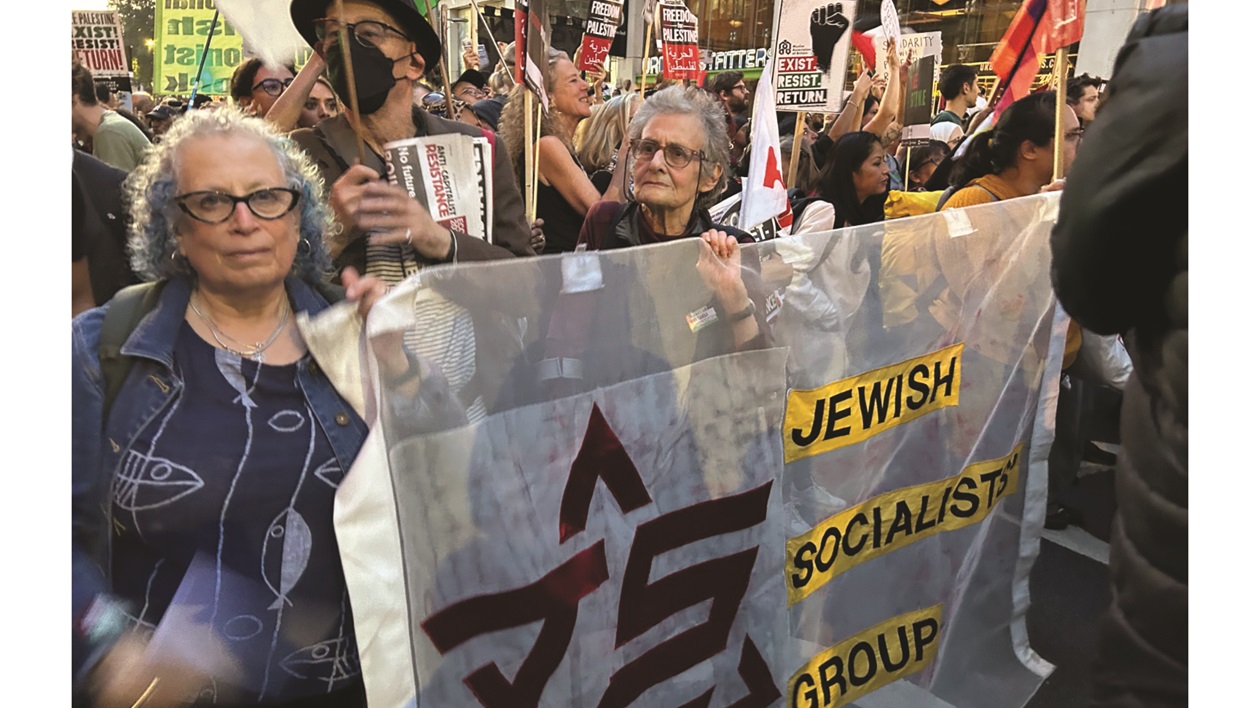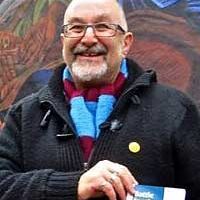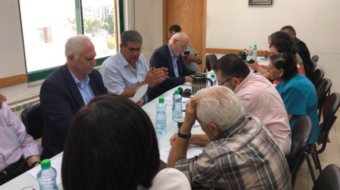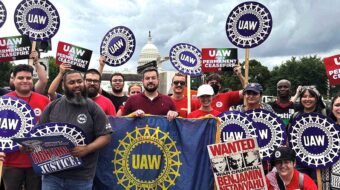
The huge demonstrations against the war on Gaza and for justice for Palestine around the world are remarkable. Overwhelmingly young, multicultural, energetic, and united, many of them have another striking phenomenon missing from mainstream media reports.
Despite the rhetoric of politicians, media commentators, and Jewish community “leaders” claiming that pro-Palestine actions are a huge affront and danger to Jews, right there among the marchers—and often organizing them—is usually a large Jewish bloc.
Looking at one big demo in London, I noticed a few things. This wasn’t the first time that Jews from different organizations were marching for Palestinian rights and justice, but the scale, demography, and spirit was different.
The bloc comprised people from their 20s to their 80s, with the balance tipped much more towards the younger age group.
There was an assertiveness and self-confidence in their political views expressed on hand-made placards: “Jews Against Genocide,” “Jews against War Crimes,” “Not in our Name” (with a star of David), “Jews Stand for Palestine.”
In the U.S., thousands of young Jews have mobilized around the message: “We refuse to let our grief be used as a justification for further bloodshed and a second Nakba.” The organization Jewish Voice for Peace has been playing a major role in organizing actions to demand a ceasefire.

All of this is taking place in a period when Israel has officially declared itself at war, and there is tremendous pressure within the Jewish community to keep any dissent safely behind closed doors.
Knowing that Israel’s government and self-proclaimed “leaders” of the Jewish community do not speak for you is one thing. Saying so publicly and so starkly, is much harder. But Jewish radicals, especially the youth, are crossing lines that go beyond criticizing the occupation with its daily human rights abuses towards a broader critique of Zionism as a whole.
Before WWII, Zionism was a minority opinion in most Jewish communities around the world. The Holocaust and its aftermath changed that, irrevocably it seemed.
Large numbers of survivors languishing in Displaced Persons (DP) camps after the war had no wish to return to countries where the Nazis had murdered their families, but the doors to Western nations were hard to prise open.
Many in the DP camps looked towards Palestine as a place of refuge. Jewish minorities in Western countries, unable to help those refugees, became emotionally drawn toward Zionism and didn’t question what Israel’s creation would mean for people already living in Palestine.
Especially from the 1960s onwards, Zionism became a dominant ideology in Jewish life in many Western countries. This coincided with a relative improvement in the material lives of many Jews who became more suburbanized and middle-income.
In Jewish educational institutions, synagogue Sunday schools, summer camps, and Jewish schools, pro-Zionism and Hebrew culture became the norm during the 1950s and ’60s.
The “Jerusalem Program” adopted by the World Zionist Congress in 1968 sought to turn a generalized sympathy towards Israel among ordinary diaspora Jews into an imperative. It promoted a political stance asserting the “centrality of Israel” in Jewish life and the “unity of the Jewish people” through “its bond to its historic homeland Eretz Yisrael (the Land of Israel).”
Official Zionist bodies, resourced by the Israeli state, set up cultural programs to reinforce this identification within diaspora communities.
The first Jerusalem Program of the early 1950s had spoken mainly of “ingathering the exiles” (regarding Jews in the diaspora as “exiles” rather than fully fledged citizens of their countries). It encouraged emigration to the new state, “aliyah,” which means “ascending,” and spoke of fostering Jewish consciousness “by propagating the Zionist idea,” stressing “Hebrew education” and “Hebrew language.”
The 1968 program went much further, declaring Zionism to be “the National Liberation Movement of the Jewish people.”
The Zionist project in Palestine had set about the erasure of Palestinian history through building on and renaming Palestinian villages, ethnically cleansed in the wars of 1948 and beyond.
More widely, the Zionist project began to downgrade and ideologically erase longstanding Jewish diaspora cultures and languages and powerful Jewish alternatives to Zionism that rose within them.
The self-confident challenge to Zionist imperatives, epitomized by the Jews who are marching now for a ceasefire and peace, is an expression of the growing interest in reviving those alternatives.
From political Zionism’s inception in 1897 until WWII, Zionists struggled to make headway in overwhelmingly working-class Jewish communities. This was the case both in the U.S. and Europe, especially in inter-war Poland, home to Europe’s largest Jewish community.
Activists who rejected Jewish nationalism in favor of class politics joined communist and socialist parties in different countries and largely became less attached to Jewish identity.
But the most powerful secular left-wing alternative to Zionism, born in the very same year as the conference that proclaimed political Zionism, was Bundism—a Jewish socialist workers’ movement with an internationalist and anti-nationalist outlook.

Its philosophy of doykayt (here-ness), stated in Yiddish, was: “Dortn vu mir lebn, dort is undzer land”—“There where we live, that is our country.” It saw a Jewish future as minorities in the diaspora, not in a fortress-style Jewish nation-state.
The Bund promoted a sophisticated multicultural model for ensuring that minority rights were enhanced as fully as possible within the states where they and other minorities lived.
More than an orthodox political program for winning a better future, Bundism specifically advanced a modern secular Jewish cultural identity—especially through Yiddish language, libraries, sports clubs, schools, newspapers, discussion circles, children’s and youth movements, and a women’s movement—which they gave agency to the grassroots.
Check out these related stories:
Within the socialist movement, they put great stress on inner democracy and clashed with advocates of more centralist models, including communists, not just with Lenin in 1903, but in Poland in the 1930s and other arenas.
In Britain, before WWI, anarchists and Bundists, who opposed Jewish nationalism, were the beating heart of progressive campaigns, especially in Britain’s largest Jewish community in London’s East End.
Between the wars, the Communist Party attracted many Jewish members there. Despite sharp differences, the “ABC” of Anarchists, Bundists, and Communists shared an emphasis on class politics and rejection of Jewish nationalism.
The Bund was decimated in the Holocaust, during which its members played a key role in ghetto resistance. Its postwar remnants were scattered in several countries and continued activities within their means but were politically marginalised by the dominance of Zionism.
Bundists in New York issued a statement in 1947 against partition of Palestine: “The peaceful coexistence of Jews and Arabs must be brought about by the renunciation of the Zionist goal of an independent Jewish state on the part of the Jewish community (and)…by the Arabs’ recognition of the democratic principle that a country belongs to its entire population.

“Palestine should thus be regarded as belonging both to the Arabs and the Jews. Palestine should become an independent state. Its freedom and equal rights of its two communities should be internationally guaranteed.”
The Jewish Socialists’ Group (U.K.) has recently published a pamphlet, The Jewish Workers’ Bund: Past, Present, Future, which includes articles by individual Bundists who were members or close to the group, and combines these with those of present-day activists influenced by Bundism. It also includes rare documentation on the terrible treatment by Zionists of Bundists in the DP camps who were resisting pressure to become part of the war in Palestine.
Today in Israel, Mesarvot—the Refuser Solidarity Network—operates as a support for Israeli conscientious objectors.
It is heartening that Bundist ideas are attracting renewed interest and providing an anti-nationalist frame of reference among Jewish radicals today.
Older and more progressive ideas are finding a renewed life and relevance and a new audience in our dangerous and unpredictable times.
“The Jewish Workers’ Bund: Past, Present, Future” is available from the Jewish Socialists’ Group.
We hope you appreciated this article. At People’s World, we believe news and information should be free and accessible to all, but we need your help. Our journalism is free of corporate influence and paywalls because we are totally reader-supported. Only you, our readers and supporters, make this possible. If you enjoy reading People’s World and the stories we bring you, please support our work by donating or becoming a monthly sustainer today. Thank you!












Comments